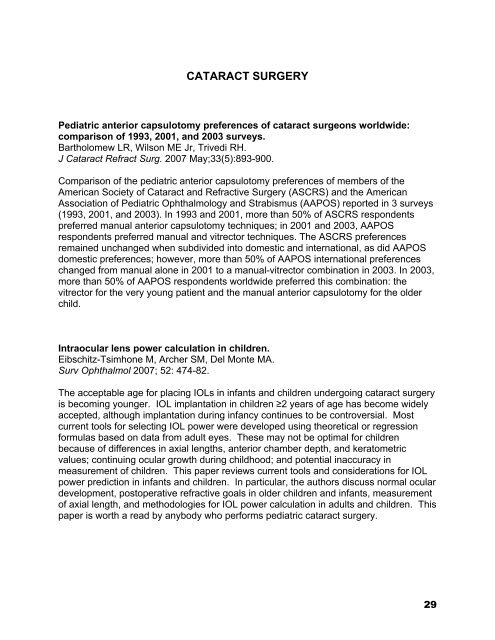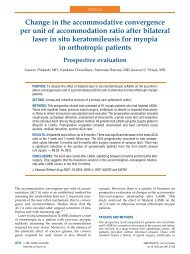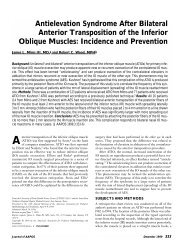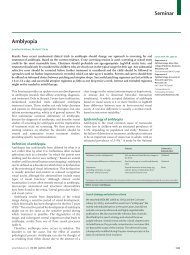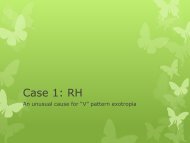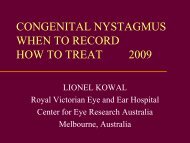What's new AAPOS 2008 - The Private Eye Clinic
What's new AAPOS 2008 - The Private Eye Clinic
What's new AAPOS 2008 - The Private Eye Clinic
You also want an ePaper? Increase the reach of your titles
YUMPU automatically turns print PDFs into web optimized ePapers that Google loves.
CATARACT SURGERY<br />
Pediatric anterior capsulotomy preferences of cataract surgeons worldwide:<br />
comparison of 1993, 2001, and 2003 surveys.<br />
Bartholomew LR, Wilson ME Jr, Trivedi RH.<br />
J Cataract Refract Surg. 2007 May;33(5):893-900.<br />
Comparison of the pediatric anterior capsulotomy preferences of members of the<br />
American Society of Cataract and Refractive Surgery (ASCRS) and the American<br />
Association of Pediatric Ophthalmology and Strabismus (<strong>AAPOS</strong>) reported in 3 surveys<br />
(1993, 2001, and 2003). In 1993 and 2001, more than 50% of ASCRS respondents<br />
preferred manual anterior capsulotomy techniques; in 2001 and 2003, <strong>AAPOS</strong><br />
respondents preferred manual and vitrector techniques. <strong>The</strong> ASCRS preferences<br />
remained unchanged when subdivided into domestic and international, as did <strong>AAPOS</strong><br />
domestic preferences; however, more than 50% of <strong>AAPOS</strong> international preferences<br />
changed from manual alone in 2001 to a manual-vitrector combination in 2003. In 2003,<br />
more than 50% of <strong>AAPOS</strong> respondents worldwide preferred this combination: the<br />
vitrector for the very young patient and the manual anterior capsulotomy for the older<br />
child.<br />
Intraocular lens power calculation in children.<br />
Eibschitz-Tsimhone M, Archer SM, Del Monte MA.<br />
Surv Ophthalmol 2007; 52: 474-82.<br />
<strong>The</strong> acceptable age for placing IOLs in infants and children undergoing cataract surgery<br />
is becoming younger. IOL implantation in children ≥2 years of age has become widely<br />
accepted, although implantation during infancy continues to be controversial. Most<br />
current tools for selecting IOL power were developed using theoretical or regression<br />
formulas based on data from adult eyes. <strong>The</strong>se may not be optimal for children<br />
because of differences in axial lengths, anterior chamber depth, and keratometric<br />
values; continuing ocular growth during childhood; and potential inaccuracy in<br />
measurement of children. This paper reviews current tools and considerations for IOL<br />
power prediction in infants and children. In particular, the authors discuss normal ocular<br />
development, postoperative refractive goals in older children and infants, measurement<br />
of axial length, and methodologies for IOL power calculation in adults and children. This<br />
paper is worth a read by anybody who performs pediatric cataract surgery.<br />
29


